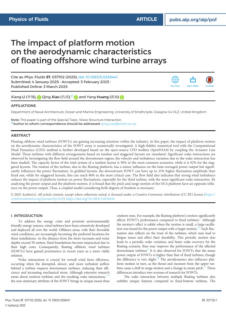Underwater construction 2024 to now







Authors: Kinga Korniejenko, Szymon G ˛adek, Piotr
Dynowski, Doan Hung Tran, Magdalena
Rudziewicz, Sebastian Pose, and Thomas Grab
Additive manufacturing, or 3D printing, as it is more
commonly known, is emerging as a game-changer in
various fields, including automated construction in
challenging environments such as underwater. However,
it is not perfect, despite having been tested in these
environments. This study explores the advancements of
3D printing for underwater applications and identifies
areas for refinement and enhancement, including
technology and materials.
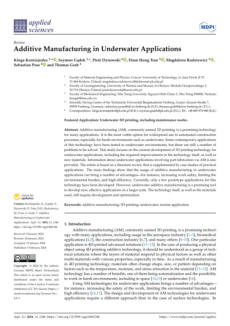


Authors:
Fantong Lin, Xianxiang Zhou, Jian Zhao, Lan Xiao, Lubo
Tang, Ziye Liu, and Jianshuai Wang
The authors used 3D models to study how underwater
explosions affect shell structures at the bottom of the
ocean. They looked at different shapes of these structures,
like half-spheres and half-cylinders made of reinforced
concrete. Using special software, they tested various
factors like the type of explosion, distance, and water
pressure. They found that these structures are damaged
more when hit by shock waves in water than in air.

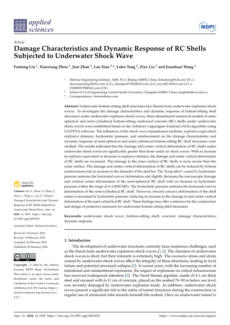


Authors: untao Sun, Jingzhu Huang, Zhiwei He, Jiahe
Wang, Dawei Zhan, Qingxiong Zhu
The study addresses the issue of blasting vibration
generated during underwater engineering, which can
cause significant damage to the surrounding
environment. It shows that predicting the blasting peak
particle velocity (PPV), which represents the maximum
velocity of ground vibration caused by the detonation of
explosives during blasting, can be utilized to mitigate
these adverse effects.
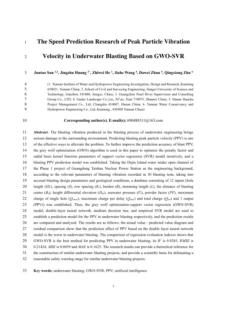


Click on the
octopus to return to
the top of the page


Authors: Mohamed ElMenshawy, Lingzi Wu, Brian Gue,
and Simaan AbouRizk
This research project aimed to automate the pipe spool
fabrication scheduling process for industrial projects. It
explains the challenges involved in the current manual
scheduling process and proposes the development of a
reinforcement learning model to handle these tasks more
efficiently. The ultimate goal is to minimize manual
intervention and improve fabrication shops' scheduling
processes.
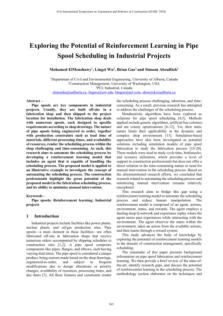


Authors: Changjing Fu, Yangming Xu, and Tianlong Zhao
This document explains the risks and mechanisms
associated with water-induced disasters affecting long-
distance oil and gas pipelines, particularly those crossing
river channels. It discusses the findings from a flume
model test that investigates the impact of unsteady flow
conditions on riverbed evolution and pipeline suspension
during floods.

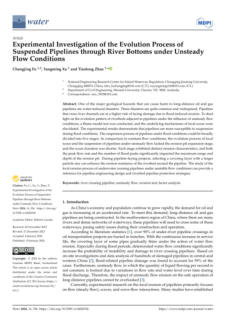


Authors:
Sung Youn Boo, Yoon-Jin Ha, Steffen Allan Shelley, Ji-
Yong Park, Chang-Hyuck Lim, and Kyong-Hwan Kim
This document describes a study focused on developing
and validating a new Tension Leg Platform (TLP) floating
wind platform with a 15 MW turbine for offshore wind
farms in Korea. The study aims to ensure the platform's
feasibility and resilience under extreme typhoon
conditions and to minimize pre-service costs and risks by
designing a wet-towable platform. The study also outlines
the design process, analysis, and validation against
industry standards to confirm compliance with design
requirements for the planned site.
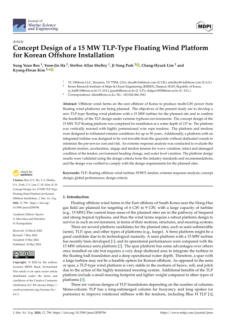


Authors:
Xiaohe Pan, Mengzhuo Liu, Jifeng Zhu, Lipeng Huo,
Zheng Peng, Jun Liu, and Jun-Hong Cui
This document discusses the development and evaluation
of a new protocol, the Robust and Adaptive Pipeline
Medium Access Control (RAP-MAC), for underwater
acoustic networks. It highlights the protocol's features,
such as its adaptability, efficiency, and robustness, and
shares the results of simulations and sea trials that
demonstrate its effectiveness in enhancing
communication in underwater environments.
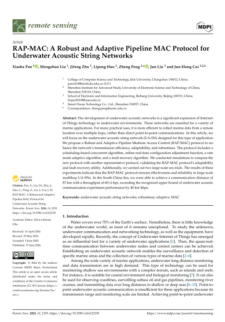


Authors:
Xiaotong Han, Liang Zhu, Xiaoxia Jiang, Wei Han Khor,
Hooi Siang Kang
This paper explains a new welding method, the flux
band-constrained arc ultra-narrow gap welding (UNGW),
for improving the quality of welded joints in underwater
cast steel pipelines. It highlights the advantages of UNGW
over traditional welding methods, describes the
experimental study conducted to optimize welding
parameters, and analyzes the microstructural and
mechanical properties of the welds. It also suggests
potential welding process improvements by manipulating
the flux band composition.
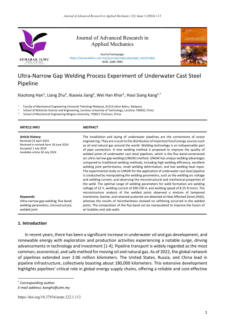


Authors: Kenneth Bisgaard Christensen, Alireza Maheri,
and M. Amir Saddiq
This study investigates the effects of ambient conditions
on cryogenic cooling times for medium-carbon steel
pipes, focusing on factors such as air velocity, ambient
temperature, and cooling medium for simulations. It aims
to validate the viability of cryogenic conditions for low-
energy fracturing in carbon steel and explores the
efficiency of a proposed cryogenic cooling and cutting
system. The research also highlights the importance of
insulating effects and discusses the trade-offs between
cooling efficiency, costs, and energy consumption.



Authors: Hongqi Ma, Haibin Xiao
This document provides an overview of the development
and implementation of intelligent construction and smart
operation technologies in the Lancang River Hydropower
Project. It summarizes the research, development, and
practical applications of these technologies, particularly in
the context of high earth–rock and roller compacted
concrete dams, and introduces specific technologies and
functions related to dam safety, engineering control,
disaster prevention, and environmental monitoring.
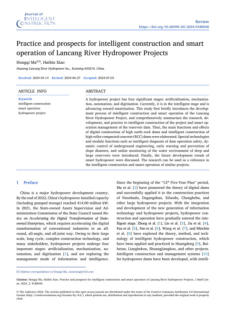
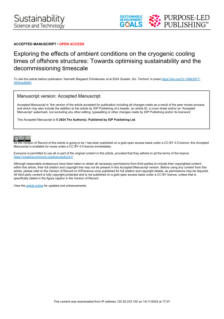


This internet link allows every person interested to access
and download the UK HSE research reports.
It must be emphasized that the UK HSE has been one of
the 1st official bodies to emit guidelines and laws to
improve the working conditions offshore and that its
impact remains essential.




05 - Development and Application of Offshore Trade Authenticity
Verification Platform Based on Blockchain
Authors: Hai-Feng Chen, Lv Zhang, Shuai Wang , Shan-
Shan Shi
Offshore trade is common in international trade, but its
hidden capital flow poses risks. Authenticity verification is
crucial for economic security. This paper presents a
blockchain-based verification platform that meets user
needs and shows good performance. It promotes
regional trade, supports financial institutions, and
empowers offshore trade development.
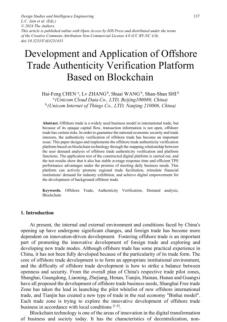



06 - A novel design of multifunctional offshore floating platform
structure based on topology optimization.
Author: Nouman Saeed, Jingliang Gong, Yuejia Wan, Kai
Long, Ayesha Saeed, Liu Mei, Chen Xiong,
Wujian Long, Haijun Zhou, Lixiao Li
Floating platforms are an affordable choice for gathering
energy in deep seawater. Key design concerns are
lightweight and structural stability, ensuring they can bear
loads. This paper presents a new lightweight offshore
platform design that uses density-based topology
optimization for wind-solar-wave energy. The design
addressed extreme sea conditions and passed strength
checks under DNV code standards, achieving a total
mass reduction of 40. 82% and improved stiffness and
durability.
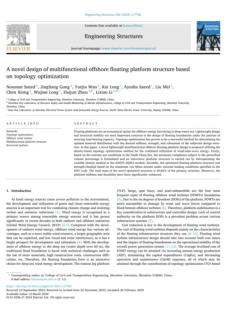



07 - A Corrosion and Repair-Based Reliability Framework for
Offshore Platforms.
Authors: Mehdi Hajinezhadian, and Behrouz Behnam
Offshore platforms are critical structures that often
experience severe corrosion, which can weaken them
over time. Although many anti-corrosion methods exist, a
comprehensive management plan is necessary for their
long-term operation. This work suggests a corrosion and
repair reliability framework for these platforms. It shows
that corrosion depth significantly impacts repair
effectiveness. The study proposes a corrosion growth
model based on various standards to aid platform
owners in safety decisions.




08 - Effect of Doping Trace Rare Earth Elements on Corrosion
Behavior of EH36 Offshore Platform Steel
Authors: Shujia Zheng, Na Liu, Yang Liu, Xiaoning Wang,
Lina Qiu, and Aijun Gong
EH36 offshore platform steel, La (0. 0031%), Ce (0.
0027%), and Pr (0. 0001%) steel were studied for
corrosion. Immersion experiments showed that rare earth
elements reduce corrosion rates. Scanning electron
microscopy (SEM) and X-ray diffraction (XRD) analyzed
corrosion products. Electrochemical tests showed rare
earths increased charge transfer resistance and decreased
corrosion current density. The influence of Cl−
concentration and temperature on corrosion rates
followed similar trends. Rare earths improved corrosion
resistance of EH36 steel.
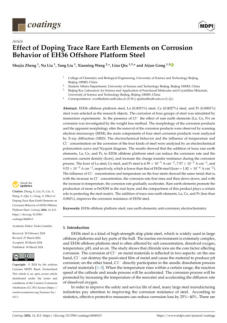



09 - Optimal design of offshore jacket platform using enhanced
colliding bodies optimization algorithm
Authors: Naser Shabakhty, Alireza Asgari Motlagh, Ali
Kaveh
Jacket platforms use a lot of materials, making their
structural optimization important. The design optimization
process is complex and slow, so efficient algorithms are
needed. This research explores the Enhanced Colliding
Bodies Optimization (ECBO) for a jacket platform,
SPD19A, comparing it to the Genetic Algorithm (GA). The
ECBO method improves the jacket's design by 15%, while
GA achieves 11%, showing that ECBO is more effective at
avoiding local optima.
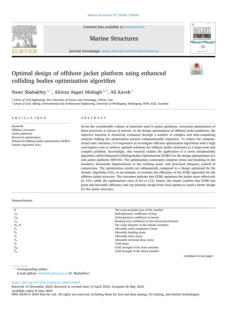



10 - A Comparative Study on Hydrodynamic Responses of Floating
Offhore Wind Turbine Platforms in Regular Waves.
Authors: Mir Tareque Ali, Md. Shariar Badon
Floating Offshore Wind Turbine (FOWT) platforms are
crucial for deep-sea conditions. This paper analyzes
semisubmersible FOWT platforms in regular waves using
Hydrostar software. It calculates wave excitation forces
and motion responses in six degrees of freedom. Three
base shapescircular, square, and hexagonalare studied,
showing minimal impact on hydrodynamic behavior.
Results may assist in FOWT design.
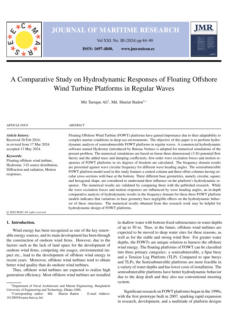



11 - Exploring the effects of ambient conditions on the cryogenic
cooling times of offshore structures: Towards optimising
ustainability and the decommissioning timescale.
Authors: Kenneth Bisgaard Christensen, Alireza Maheri,
and M. Amir Saddiq
This study looks at how ambient conditions affect cooling
times for medium-carbon steel pipes during cryogenic
processing, focusing on air velocity, ambient temperature,
and cooling medium. Results show increased cooling
times with certain conditions, validating cryogenic
methods for carbon steel. The research emphasizes the
significance of surface area and discusses the balance
between cooling efficiency and costs. It aims to support
Sustainable Development Goals by promoting eco-
friendly cryogenic technologies for offshore structure
decommissioning.
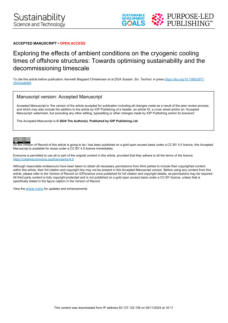



12 - Virtual Inertial Control of Small- and Medium-Sized Wind
Turbines on Mobile Offshore Platforms with DC Microgrids.
Authors: Ruifang Zhang, Guoling Wang, Zhenyu Li,
Fuqiao He, Chenghan Luo, and Wensheng
Cao
The renewable energy mobile offshore platform uses a
mix of renewable energy and energy storage to support
marine resource development. Due to the unpredictable
nature of renewable energy, a virtual inertia control
method for small- and medium-sized wind turbines is
proposed to enhance stability. The method uses the wind
turbine's mechanical inertia and is verified through
experiments on a DC microgrid platform.
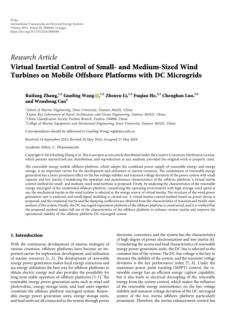



16 - Event-Triggered Neural Adaptive Distributed Cooperative
Control for the Multi-Tug Towing of Unactuated Offshore
Platform with Uncertainties and Unknown Disturbances.
Author: Shaolong Geng, Yulong Tuo, Yuanhui Wang,
Zhouhua Peng, and Shasha Wang
An event-triggered neural adaptive cooperative control is
proposed for a towing system with uncertainties. It uses a
neural network to manage disturbances and ensures
desired drag force. A mechanism reduces
communication needs and thruster frequency. The
system's stability is confirmed, and the effectiveness is
shown through simulations.
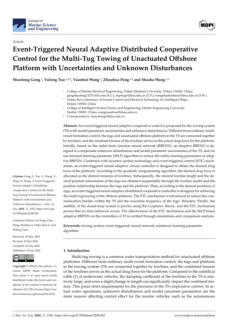



17 - Hydrodynamic performance of a submersible net cage
integrated with an offshore platform

Authors: Zhenglin Tian, Hui Yang, and Hongjie Wen
The integrated development of offshore platforms and
net cages is important in ocean engineering. A composite
structure is proposed, combining a submersible net cage
with the steel pipe piles of an offshore platform to
improve cost-effectiveness and use ocean resources
better. A numerical model using OpenFOAM software
assesses its hydrodynamic performance. The model is
validated and used to study velocity variations and forces
on the steel piles at different submerged depths.
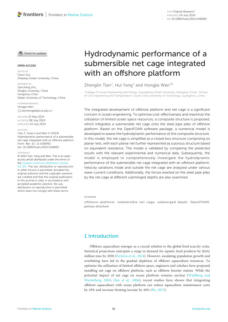



20 - Reliability Analysis of a Four-legged Jacket Offshore Platform: A
Case Study.
Authors: Hastuti, RW Prastianto, D M rosyid, F Syalsabila,
M R Syarifudin
Offshore oil and gas exploration needs reliable
infrastructure, focusing on structural reliability. Designs
often use fixed values, but random factors can vary. This
research uses the Monte Carlo method to assess the
reliability of a jacket platform in Indonesia, yielding high
reliability scores of K = 0. 9883 and K = 0. 9963 for
operating and extreme loads, respectively, indicating
safety under analyzed conditions.




21 - Benchmark Dataset for Offshore Platform Motion Prediction
and Its Applications.
Authors: Wenyin Pan, Xiaoxian Guo, and Xin Li
Accurate prediction of offshore platform and ship motion
is important for compensation devices and crew
decisions. Machine learning models are replacing
traditional methods due to simplicity and lower costs, but
limited data complicates model training. This paper
presents a motion dataset from over 400 offshore
platform tests at Shanghai Jiao Tong University, divided
for various applications. A new Convolutional Attention-
based Long Short-Term Memory model improves motion
prediction accuracy by 5–10% compared to classical
models, proving the dataset’s reliability and the model's
effectiveness.
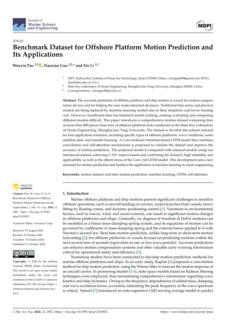



22 - Optimization Simulation of Mooring System of Floating Offshore
Wind Turbine Platform Based on SPH Method
Authors: Weibo Du, Peigang Jiao, Kangning Li, Jiaming
Ding
This paper utilizes the Smoothed Particle Hydrodynamics
method to simulate the dynamic behavior of a floating
offshore wind turbine mooring system in a complex
marine environment. It introduces single-cable and
double-cable systems in the model, using both first-order
irregular and second-order regular waves for different
conditions. The platform's performance is analyzed,
yielding data on velocity and six degrees of freedom
changes. The findings show that the optimized double-
cable mooring system enhances the platform's vibration
reduction capability.
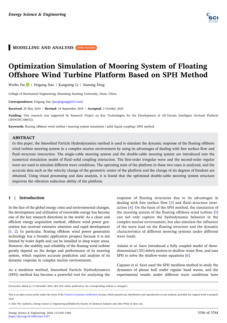



23 - Numerical investigation on hydrodynamic response of a SPAR
platform for offshore wind energy.
Authors: Arya Thomas, V.K. Srineash, and Manasa Ranjan
Behera
COP28 has urged governments to shift from fossil fuels to
renewable energy like wind and solar power. This study
investigates a SPAR-type Floating Offshore Wind Turbine’s
responses under various wave conditions and mooring
line setups. It examines how freak waves impact the
turbine and analyzes wave-structure interactions using
numerical modeling. The findings highlight that taut
mooring configurations effectively stabilize the turbine
during freak waves, contributing to understanding
mooring performance under varying conditions..




24 - Study on the Prediction of Motion Response of Offshore
Platforms Based on ResCNN-LSTM.
Authors: Feng Diao, Tianyu Liu, Franck Aurel Likeufack
Mdemaya, and Gang Xu
In a random sea environment, offshore platforms are
affected by wind, waves, and currents, making their
motion responses complex. This paper uses STAR-CCM+
to simulate offshore platform motion under regular and
irregular waves. A predictive model combining
convolutional and long short-term memory neural
networks is developed to forecast motion responses,
showing high accuracy with R² values over 0. 99 for
regular waves and above 0. 4 for irregular waves. The
study aims to improve decision-making for offshore
platform operations.



27 - Applying Neural Networks to Predict Offshore Platform
Dynamics
Authors: Nikolas Martzikos, Carlo Ruzzo, Giovanni Malara,
Vincenzo Fiamma, and Felice Arena
Integrating renewable energy with aquaculture on
floating platforms promotes sustainable offshore
infrastructure. A prototype tested in Italy provided insights
into structural behavior. The study uses Artificial Neural
Networks to predict mooring load changes. Several
models were analyzed, achieving a Normalized Root
Mean Square Error of 1. 7–4. 7%. Results show machine
learning's potential in ocean systems management.
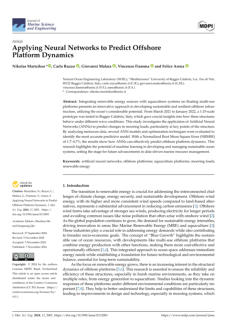



28 - OC6 Phase IV: Validation of CFD Models for Stiesdal TetraSpar
Floating Offshore Wind Platform
Authors:
Hannah Darling, David P. Schmidt, Shengbai Xie,
Jasim Sadique, Arjen Koop, Lu Wang, Will Wiley,
Roger Bergua Archeli, Amy Robertson, Thanh Toan Tran
Floating offshore wind turbine (FOWT) technology is
new and relies on modeling tools for development. The
OC6 project aims to verify these tools. The Stiesdal
TetraSpar platform was simulated with CFD under OC6
conditions, showing good predictions of wave response
but some damping issues due to uncertainties. The study
provides insights into achieving reliable results.




29 - Study on Motion Response Prediction of Offshore Platform
Based on Multi-Sea State Samples and EMD Algorithm.
Authors: Tianyu Liu, Feng Diao, Wen Yao, Franck Aurel
Likeufack Mdemaya, and Gang Xu
Offshore platforms must handle changing marine
environments, requiring analysis of their motion under
various conditions. This study uses STAR-CCM+ software
to assess platform responses to different wave directions
and heights. The method enhances forecasting of
offshore structures' dynamic responses, supporting safer
and more productive maritime operations.
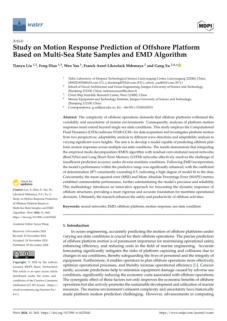



30 - Design for additive manufacturing of topologically optimized air
manifold
Author: Nikolaos Kladovasilakis
Topology optimization is used in mechanical design for
lightweight and cost-effective solutions. This study outlines
a workflow for redesigning a low-pressure air manifold
using advanced design. Iterative finite element analyses
removed excess material and improved structural
integrity, resulting in a design 76% lighter than the
original, costing under €5 per item. This workflow can
apply to various 3D-printed mechanical parts in different
industries.
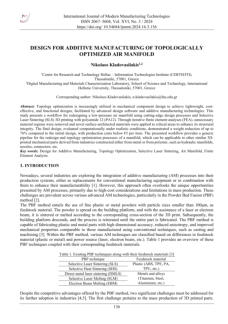



31 - Structural Effectiveness of Fixed Offshore Platforms with Respect
to Uniform Corrosion.
Authors:
Abubakar O. Salihu , Kolawole Abejide, Olugbenga S.
Abejide, Jibrin M. Kaura, Ibrahim Aliyu, Kehinde Adeshina,
Olugbenga S. Abejide
This study evaluates the effectiveness of fixed offshore
platforms under complex marine conditions. Using Finite
Element Analysis and Monte Carlo’s reliability method, it
assesses how corrosion and environmental loads affect
structural performance. Results show high stress in beam
and column connections. Choosing high-grade steel and
larger cross-sections can enhance durability and safety.
The findings underscore the need to consider material
properties, connections, and loading in design to improve
offshore platform reliability.
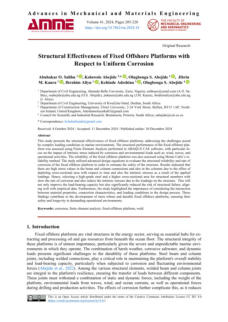



32 - Effectiveness of deck-isolation and viscous dampers supplement
on enhancing seismic performance of offshore jacket platforms
Authors: S. Dashti, K. Tarbali, C. Zhou, J.G. Chase
Offshore structures used for oil production are adapting
for renewable energy. This study assesses the seismic
performance of a typical offshore jacket platform and
two modified versions with isolation systems. Ground
motion ensembles are selected based on the site’s
seismic hazard. Results show significant reductions in
displacement, acceleration, and base shear with the
application of a specific damper.
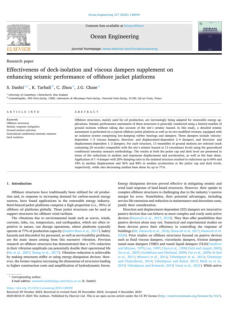



33 - Local Structure Optimization Design of Floating Offshore Wind
Turbine Platform Based on Response Surface Analysis.
Authors:
Yajun Ren, Mingxuan Huang, Jungang Hao, Jiazhi Wang,
Shuai Li, Ling Zhu, Haisheng Zhao, and Wei Shi
The floating platform is essential for the floating offshore
wind turbine (FOWT), with its internal design being
crucial for safe operation. The study parameterized the
local model, created a response surface model through
an orthogonal test, and optimized it using a gradient
descent algorithm. Safety calibration confirmed the
internal structure arrangement. The optimized model
shows a 22. 12% reduction in maximum stress without
changing mass and centroid, enhancing safety and
offering useful insights for FOWT platform design and
construction.
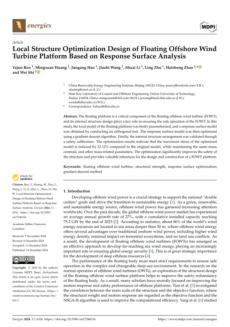



34 - Methodological proposal for satellite communication on
offshore self-elevating platform.
Authors: Ricardo A. Barrera Cámara, José R. González -
Reda, Alejandro Fuentes-Penna
The use of information and communication technologies
improves work and communication, but challenges exist
in remote areas. The goal is to implement a satellite
communication system for offshore platforms using VSAT
technology, following a tested methodology.
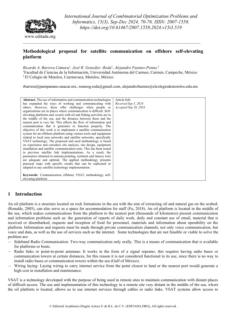



35 - Multi-Antenna GNSS–Accelerometer Fusion Attitude Correction
Algorithm for Offshore Floating Platform Displacement
Monitoring.
Authors: Xingguo Gao, Junyi Jiang, Guoyu Xu,
Zengliang Chang, and Jichao Yang
A new attitude correction algorithm was proposed to
improve GNSS displacement monitoring on offshore
floating platforms by blending multi-antenna GNSS and
an accelerometer using Kalman filtering. The method was
tested successfully, enhancing accuracy and
compensating for low sampling rates.




36 - Synergic sensing of light and heat emitted by offshore oil and
gas platforms in the South China Sea.
Authors: Yujia Qiu, Xiao-Ming Li, Lin Yan, and
Zhongzhong Chen
The growing demand for oil and gas requires customized
monitoring of platforms. Remote sensing is effective, but
has limitations. The SDGSAT-1 offers high-resolution
imaging and has been used to detect gas flaring at 113
active platforms in the South China Sea.
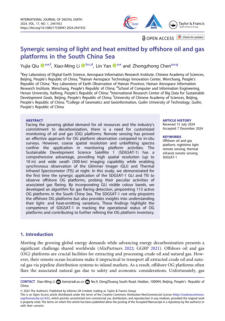



37 - Control of nonlinear offshore platforms using semi-active tuned
mass damper inerter under combined wave and wind loads
Authors: Seyyed Ali Mousavi Gavgani, Seyed Hossein
Hosseini Lavassani, Gebrail Bekdas
The paper studies the Semi-Active Tuned Mass Damper
Inerter (SATMDI) for reducing vibrations in offshore
platforms responding to wind and wave loading. It uses
an interval type-2 fuzzy logic controller (IT2FLC) optimized
with an observer-teacher-learner-based optimization
algorithm. Results show that SATMDI + IT2FLC can greatly
reduce energy effects, preventing structural plasticity, with
example reductions of 91% in inter-story drift and 83% in
absolute acceleration for a 100-year loading scenario.
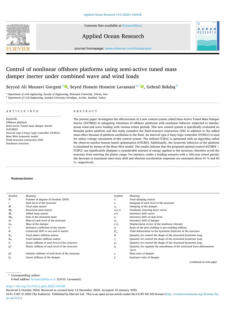



38 - A Comprehensive Study on Environmental Impacts of Offshore
Platforms Abandonment and Decommissioning in Malaysia.
Authors: Nuraiesya Khanoon Thariq Khan, Nurfarah
Farhana Nurisman, Asheeka Razali, Mohd Haris
Abdul Rani
PETRONAS plans to increase the abandonment and
decommissioning of offshore platforms from 2024 to
2026. Malaysia's oil and gas sector, contributing about
20% to the GDP, requires eco-friendly methods to prevent
environmental harm. The study reviews sustainable
dismantling practices, balancing economic and ecological
needs.
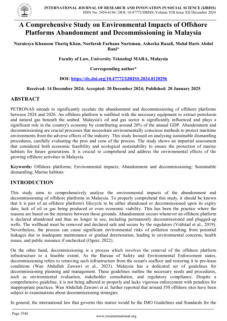



39 - Tether analysis and stability investigation of space rocket launch
offshore compliant platform in regular seas.
Authors: Srinivasan Chandrasekaran, Ashish
Unnikrishnan, and Adwait Panindre
This study looks at the stability of a multi-utility offshore
platform for rocket launches, focusing on tether
dynamics and platform behavior. The platform, modeled
in ANSYS AQWA, has buoyant legs and a topside linked
by ball-and-socket joints, allowing motion while keeping
rotations separate. The extended topside needs stability
checks due to pitch moments. Free-decay tests show
rigid heave and pitch motions (~3 s) and flexible surge
motions (~150 s). Dynamic tether analysis in different sea
states shows simultaneous tether failures significantly
affect platform stability, causing major shifts in heave and
pitch.
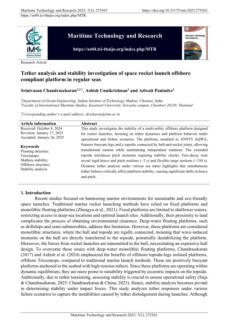



40 - Design of a Semi-Submersible floating platform for Floating
Offshore Wind Turbine (FOWT) IEA 15-Megawatt
Authors: Zulqarnain Ali, Ahmad Hassan, Sascha Kosleck,
Ghaith Esber
This study proposes solutions for designing a semi-
submersible platform for a 15-MW wind turbine, located
300 meters deep with a height of 165 meters above
water. It uses structural steel and concrete for stability and
examines the platform's dynamics while ignoring
mooring effects. Structural analysis includes pitch and
stability calculations. Advanced simulations assess heave
responses and wave interactions, achieving a 20%
reduction in dynamic response and 25% improvement in
energy efficiency. The framework aids in marine
engineering, and future work may include testing and
machine learning for better design.
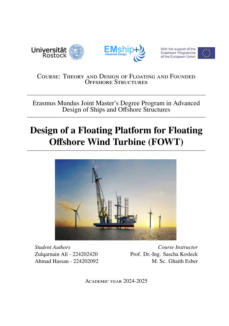



41 - Analysing the legal and regulatory framework for
decommissioning offshore platforms: a comparison between
brazil (br) and the united kingdom (uk).
Authors: Elesito Lelo-Mali Cairo de Deus, José Adolfo de
Almeida Neto, Attawan Guerino Locatel Suela
This article analyzes the legal aspects of the
decommissioning process in the United Kingdom and
Brazil through a systematic literature review. It examines
norms related to offshore platform decommissioning in
both countries, finding that they align their policies with
international sustainability standards. However,
implementation issues arise, especially in Brazil, due to
conflicts of interest. The study suggests areas for future
research to improve policy application and resolve these
conflicts.




42 - The impact of platform motion on the aerodynamic
characteristics of floating offshore wind turbine arrays.
Authors: Xiang Li, Qing Xiao, and Yang Huang
Floating offshore wind turbines (FOWTs) are gaining
attention. This paper examines how platform motion
affects the aerodynamic features of a FOWT array using a
high-fidelity numerical tool developed from OpenFOAM,
a powerful, open-source software for computational fluid
dynamics (CFD). Three turbine arrangements are
simulated, showing significant wake interactions. The
capacity factor varies by layout, while platform motion
influences power fluctuations. A coupled model
considering both pitch and surge motion is needed.
